Have you ever faced with this kind of problem: You want to have a panoramic tour in China, but your budget is not enough? Then our 18 Days China Panoramic Budget Tour will probably satisfy your needs, lasting for 18 days and covering several famous cities with different experiences. Do you want to visit famous ancient cities to feel the historical significance? Come to Beijing and Xi’an. Let’s go and appreciate these wonderful masterpieces left by the ancient people. Our budget Beijing tours contain the most recommended attractions, all of which are carefully selected to suit your budget needs and help you save money. Also, our mode of transportation is very economical. For example, after the Beijing budget tour, we will head towards Xi’an by taking the overnight train. You will arrive at the destination after one night’s sleep, which is money-saving and time-saving. After visiting the ancient cities, do you want to go to places with beautiful scenery to have a mental rest? Then our cheap tours in Yunnan will help you clear your scattered thoughts and refresh your mind. All in all, our goal is to help tourists enjoy the good services but spend less. Stop hesitating and join this journey of a cheap panoramic China tour.

Upon your arrival, our local tour guide will be waiting for you and send you to the hotel. Welcome to our first stop, Beijing, the capital of China and a famous historical and cultural city. It covers a total area of 16,410 square kilometers. There is around 21.89 million permanent population in Beijing. Beijing is rich in cultural deposits. The historical and cultural relics are enormous, all of which are not only the treasures of China, but also the invaluable heritage of the world. Except for the attractions, the food in Beijing, especially Beijing Roast Duck has long enjoyed a good reputation. There are also some traditional Beijing delicacies waiting for you to explore.
The Tian’anmen Square is about 880 meters long and 500 meters wide. It is the biggest city square in the world, which can contain 1 million people for big ceremonies and events. Do you know how Tian’anmen Square was formed into what it is today appearance? After the founding of the people’s Republic of China, the government decided to make transformations to the square in 1958. Premier Zhou decided to preserve the Tian’anmen Gate Tower and build the Museum of Chinese History on the east side of the square, the Great Hall of the People on the west, and the Monument of the People’s Heroes in the middle. Then the whole Tian’anmen Square was formed reflecting the theme of “people first, and the poeple are the rulers of the country”. This theme completely negates the old theme of “the imperial power is the first”. Therefore, the transformation of the square has a great significance. Building the new square is in accordance with the new era and the new China.
The Forbidden City (closed each Monday) used to be the imperial palace in the Ming (1368-1644) and Qing (1636-1912) Dynasties. Nowadays, it is one of the greatest architectures in Chinese history and also the greatest imperial palace with the largest scale in existence. The whole palace is divided into the inner court and the outer court. The outer court used to be the place where the emperors dealt with political affairs and held big ceremonies. The inner court used to be the place where emperors and concubines lived. The Palace of Heavenly Purity is the most famous palace in the inner court, which used to be the living palace of the emperors. Do you know why are there 27 beds set inside the palace? The reason is closely related to the 11th emperor of the Ming Dynasty, Zhu Houcong. In the early years of his reign, he worked diligently and made extraordinary achievements in political, economic, as well as cultural fields of the country. But he changed into a different person in his later years. He indulged himself in pleasure and was sometimes a bit moody. The maids serving in the palace had enough of him and decided to assassinate the emperor when he fell asleep. They failed in the end, but from then on, the emperor became really careful and set 27 beds in the palace. This way, no one would be able to know where the emperor would sleep at.
The Jingshan Park used to be the back garden of the royal families in the Ming and Qing Dynasties and is now a very popular park among the local people and tourists. The peak of Jingshan is about 43 meters high. Standing on the sightseeing platform of the mountain top is the best way to have a panoramic view of Beijing city and its symmetrical beauty.
In the afternoon, you will take the Rickshaw (a traditional mode of transport, a tricycle) to casually enjoy the scenery in Hutong, the narrow alleys in Beijing. Here in the Hutong, you can experience the most authentic style and customs of the old Beijing people. You can also have a chance to go inside one of the traditional dwellings of local people to appreciate the beauty of local architecture.
The Summer Palace is the best-preserved and most complete imperial garden in the world. It is situated in the west suburban areas of Beijing, about 15 kilometers away from downtown Beijing. And it takes about 40 minutes to drive there. The Summer Palace covers a total area of 290 hectares. The building of this garden was ordered by emperor Qianlong of the Qing Dynasty, who would like to build a place where his mother could enjoy her old age peacefully. Emperor Qianlong himself was really fond of mountains and waters in Hangzhou, so he asked the workers to build this garden based on the style of gardens in Hangzhou. There are so many famous tourists attractions in the Summer Palace, such as the 700-meter-long Long Corridor with over 1,400 pieces of paintings on its square beams. The paintings present stories from classical literature or some local folklore that enjoyed great popularity. Walking along this corridor is a great way to know about traditional Chinese culture. Let me introduce one of them: There is one painting that presents a story about the Qixi Festival (Chinese Valentine’s Day). A long time ago, there was a poor farmer, the Cowherd, who had nothing but an old cow keeping him company in the mortal world. And there was a beautiful goddess named Weaving Maiden, living in the heaven. One day, the Weaving Maiden came to the mortal world secretly to play around. During her trip in the mortal world, she met with the Cowherd and the two fell in love with each other. The Weaving Maiden then decided to live in the mortal world with the Cowherd. But soon, the Queen Mother of Heaven knew about this. She bursted into anger and sent soldiers to catch the Weaving Maiden back to heaven. She even created a Milky Way separating the Weaving Maiden and Cowherd on two sides. The couple were separated eversince but never forgot about each other. A group of magpies felt touched by their love and formed a bridge to help the Cowherd get through the Milky Way. Later, the Queen Mother allowed them to meet once a year on July 7th. This day is the Qixi Festival in China.

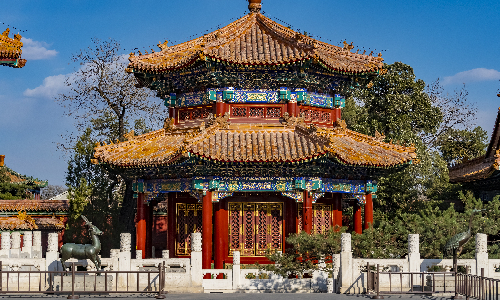
In the morning, we will drive northwest for an hour and a half to get to our destination, the Ming Tombs. The Ming Tombs are the mausoleums of a total of 13 emperors in the Ming Dynasty. Covering about 40 square kilometers, it is the largest imperial tomb complex in existence in China.
Stepping on the Sacred Way, you are on the way to the tomb complex. This way extends for about 7.3 kilometers. Along the way, you will see some stone-carving statues. Some of them are carved into the shape of animals and human figures. These statues were made to guard the tomb and protect the owner. Walking along the Sacred Way, you might be gradually influenced by the solemn and quiet atmosphere here.
Among the 13 tombs, the Chang Tomb is the best-preserved one with the largest scale. In 1409, the construction of Chang Tomb started, which is the first one in the 13 tombs. The owner of the tomb is the third emperor of the Ming Dynasty, Zhu Di. Zhu Di had devoted himself to the stability and development of the country and achieved enormous contributions during his reign. For example, the Maritime Silk Road was opened up during his reign.
In the afternoon, we will drive southwest for about 26 minutes, which is about 24 kilometers away from Chang Tomb. Our next stop is the Juyongguan Great Wall. It is called by the public as the most impregnable pass in the world. It used to be the significant barrier for northwest Beijing in ancient times. Standing on the Juyongguan Great Wall and looking around, you can imagine the scene in the past: even if there’s only one man guarding the pass, ten thousand people are unable to get through. Among all the sections of Great Wall, Juyongguan Great Wall will cost you the least money. Because in sections like Mutianyu Great Wall and Badaling Great Wall, tourists need to take other transportations, like cable cars. But you don’t need to take those in this section. Therefore, the section of the Juyongguan Great Wall is more economical, which can ensure you get the same views of the Great Wall at a cheaper price.
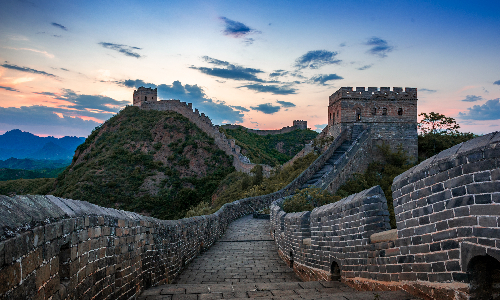
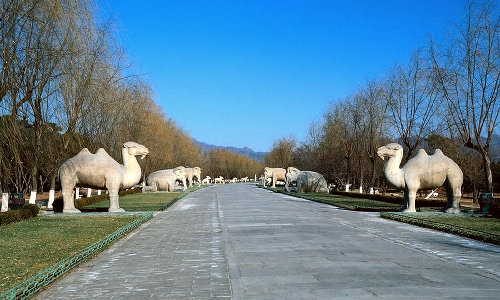
 Xi’an
Xi’an Today you will first go to the Temple of Heaven. The Temple of Heaven covers a total area of 273 hectares, which is almost 4 times the size of the Forbidden City. During the Ming and Qing Dynasties, emperors used to hold sacrificial ceremonies here and pray for good harvests in the coming year. In ancient times, people were afraid of bad weathers as that might lead to bad harvest. Today, it has become a park for leisure activities of local people. During your visit, you might be able to find some local people playing Tai Chi in the park. Tai Chi is a type of traditional Chinese exercise, focusing on both the mental and physical exercises. If you are interested in it, just feel free to join the locals and imitate their motions. The moves are slow but they go on continuously without pauses, and are really good for your health. Feel free to have a try!
In the afternoon, you will visit the Silk Street Market, a well-known shopping center and a paradise for shopaholics. There are many small shops selling clothes, silk, pearls, traditional Chinese handicrafts and so on. You can buy some commodities for yourself or some souvenirs for your friends.
In the evening, you will take the estimated train T231 18:35/07:36+1 to Xi’an. After one night’s sleep, you will arrive at your new destination. Staying overnight on the train will save your money for hotels and also your time. We will arrange the soft sleeper for you.
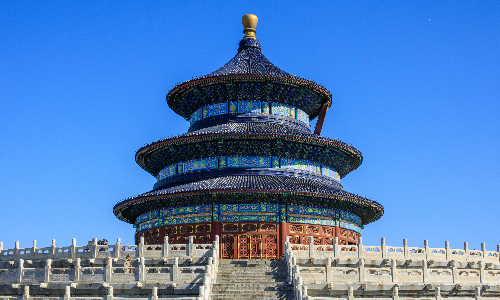
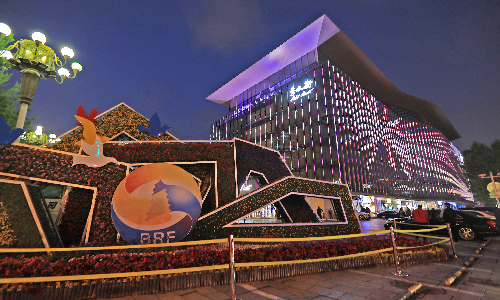
Our local tour guide in Xi’an will pick you up at the train station upon your arrival. Then the guide will take you to a local restaurant to have breakfast. Xi’an covers an area of 10,108 square kilometers and has a permanent population of more than 12 million. Xi’an used to be the capital city of about 13 dynasties in ancient times. It is a famous historical and cultural city. The historical relics and attractions here are abundant, such as the Bell Tower, the City Wall, and the world-famous terra cotta warriors and horses. The foods here also won’t let you down, for example, the Rougamo (marinated meat in a baked bun), Pita Bread Soaked in Lamb Soup, and various kinds of noodles.
After breakfast, we will drive northeast for about 45 minutes (a distance of about 40 kilometers) to get to your first stop, the Terra Cotta Warriors and Horses Museum. The terra cotta warriors and horses are collectively known as an invaluable heritage and also the Eighth Wonder of the World. The terra cotta warriors and horses here were discovered in 1974, at the place around 1.5 kilometers away from the mausoleum of Emperor Qin Shihuang, the First Emperor of the Qin Dynasty (221-207 B.C.). These terra cotta statues were made to be buried with the emperor as burial objects. Up to now, about 7,000 terra cotta warrior statues and hundreds of horses as well as chariots were excavated. The warriors were so carefully produced into every detail, such as the hair and the tread of the shoes. If you look carefully, you will be surprised to find out that among the 7,000 warriors, you can’t find any two statues with the same appearance. Every warrior is unique.
Next, your guide will take you to the Big Wild Goose Pagoda. The Big Wild Goose Pagoda was built in 652 of the Tang Dynasty (618-907). The great monk, Xuanzang went to India to study Buddhism and brought back a lot of precious statues and scriptures. Then he advocated building this pagoda to store and worship these scriptures and statues. There are so many legends about the origin of the name of this pagoda. One legend has it that during the westward journey to get the scriptures, monk Xuanzang once got lost in the desert. Just when he was desperate for some water to drink, a wild goose passed by and led him to find a pond, which saved his life. Then he gathered together his strength and walked out of the desert. He went on his journey to India and successfully brought back a great number of precious scriptures and Buddha statues. To show gratitude to the wild goose that saved his life in the desert, Xuanzang decided to name the pagoda as “Big Wild Goose Pagoda”.
Then, you will continue your tour to the Great Mosque. The Great Mosque has been in existence for about a thousand years. What is unique about this mosque is its architectural style. Basically, Muslim mosques are very easy to identify as they are usually with round shapes and spires. But this one has broken the rules of the traditional architectural style and combined the Chinese style with the Muslim style.
After visiting the above attractions, let’s seek some food in the Muslim Quarter, a popular food street for the local people and tourists. Let me recommend some local favorites to you. The Rougamo is a kind of baked bun with marinated meat inside. The meat inside is a perfect integration of the beef fat and muscle, which tastes great with the bun. The cold noodles is really popular among young people. It is mixed with the spicy sauce, which is the secret that makes it flavorful and can stimulate your appetite. The chili sauce in Xi’an is not too spicy and tastes really good. The Jing Gao, also known as Mirror Cake, is a type of desert. It got its name because the shape of it is like a round hand mirror. It is made of glutinous rice. The sellers will usually pour different kinds of sauce or jam on it to add flavor.
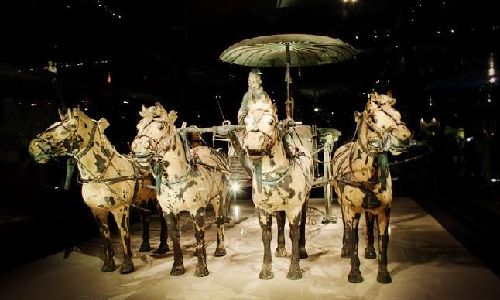
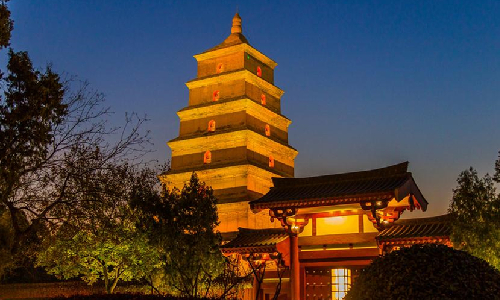
 Chengdu
Chengdu After breakfast, you will be transferred to the train station and take the estimated bullet train D1917 09:00/12:17 to Chengdu. Our local tour guide will wait for you there and send you to your hotel in Chengdu. The afternoon is your own time to explore. Chengdu is the provincial capital of Sichuan province. It covers a total area of 14,335 square kilometers and has a permanent population of over 20 million.
In Chengdu, there is a variety of different local delicacies, such as cold jelly noodles, grilled fish, spicy noodles, and most importantly, Chengdu hot pot. Once you come to Chengdu, you don’t need to worry about not knowing what to eat. The only worry you might have is whether your stomach is big enough!
In the morning, we will visit the Chengdu Research Base of Giant Panda Breeding to see the national treasure, pandas. Here you can have closer contact with the adorable pandas. Please remember to turn off the flashlight when you are taking pictures of the pandas, especially the panda babies, as that might hurt their eyes. And it is prohibited to feed the pandas, as there are designated staff to feed them with balanced food arrangements. After visiting, you can buy some souvenirs back, such as the cute panda toys.
In the afternoon, we will go to the People’s Park, a popular park among the local people. In many tourists’ views, this park is the best place to experience the most authentic local customs and styles. Here, you can enjoy the chrysanthemums (when in right season), drink tea, and go boating. There is also a blind date corner set in the park for single people to share their basic information. But for most of the Chengdu people, the reason why they go to the People’s Park is that they like to drink tea in the Heming Tea House. This tea house has already existed for more than 100 years. Every afternoon, the local people would like to gather together here, drink tea, and enjoy the sunshine as well as the ear-picking service. This has become the typical leisurely life of local people.
The Wuhou Shrine that you are going to visit next is the historical site of the Three Kingdoms period (220-280). The shrine was built to commemorate the great strategist, Zhuge Liang, of the kingdom of Shu (221-263). He had given his all to the country until his heart ceased to beat. People admired this spirit of Zhuge Liang and built Wuhou Shrine to show their respect to him. Stepping inside, you might feel that you have gotten away from all the noise of the city and simply immerse yourself into the solemn atmosphere of the Wuhou Shrine.
Then you will go to Jinli Street. Jinli Street is praised by foreign countries as the world’ s most beautiful characteristic street. Walking around, you will find that every corner of the street is suitable for taking pictures. And they will make a good post on your social media. Also, you can enjoy many special activities at your own expense there, such as ear-picking and watching the Sichuan opera.
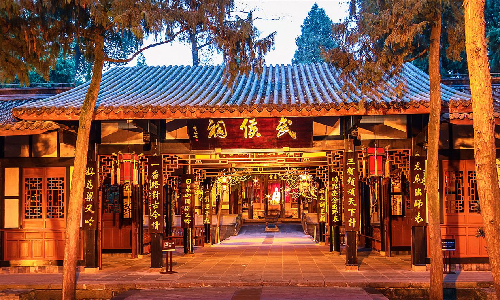
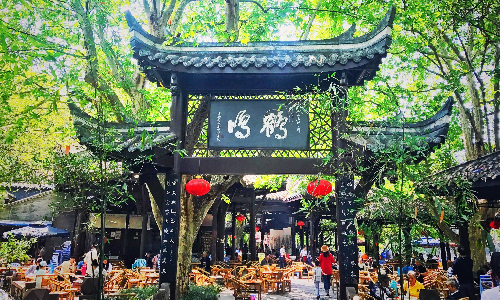
In the morning, we will visit the spectacular Leshan Giant Buddha. We will drive to the south for about 2 hours with a distance of about 153 kilometers. The building of this Buddha statue started in the Tang Dynasty (618-907) and lasted for about 90 years with the efforts of three generations of craftsmen. The height of the statue is about 71 meters, and each eye of the statue is about 3 meters long. It is with no doubt the tallest and largest stone-carving Buddha statue in the world.
In the afternoon, we will visit the Huanglongxi Town, one of the ten famous ancient water towns in China. The town is not only famous for its beautiful scenery and environment, but also well-known as a photography and movie-shooting place. A lot of people would choose to come here with their families.
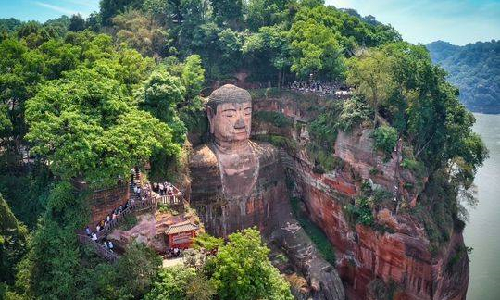
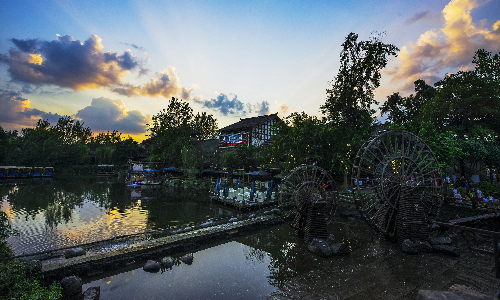
 Guilin
Guilin Today, you will take the estimated train D1801 09:10/10:55 to Guilin. Our local tour guide will wait for you at the airport and send you to the hotel. Guilin is the most popular tourist city in Guangxi province and its name has also been spread to the world. It covers an area of 27,800 square kilometers and has a permanent population of 4.93 million. Guilin is famous for its great mountains and lucid waters. As early as 1,000 years ago, a poet has already made great comments on Guilin, saying “The mountains and waters of Guilin are the finest in the world”. Until today, Guilin is still attracting numerous people who are searching for great scenery.
In the morning, after driving towards the southeast for about 40 minutes with a distance of 23 kilometers, we will arrive at the Mopanshan Port to have the Li River Cruise tour. You can have closer contact with the beautiful mountains and lucid waters on the cruise ship. Don’t forget to take some nice pictures during this 4-hour journey, as they will make some nice posts on your social media!
In the afternoon, you will disembark at Yangshuo and your guide will take you to the Yangshuo West Street, a popular pedestrian shopping street with all kinds of bars, tea houses, coffee shops, snack stores, and some handicrafts stores. Here I’d like to introduce three types of local food for you. The first one is the famous beer-fish. Stewed only with beer, the fish meat tastes really soft and is rich in fragrance. The second one, Guilin rice noodles is a really popular local staple food. The soft and smooth rice noodles taste great with the special sauce and the sour bamboo shoots. The third one, Ciba, is a type of dessert, really popular among young people. It is made of glutinous rice by pounding the steamed glutinous rice into the paste and frying it. Accompanied with some sweet sauce, it tastes really good.
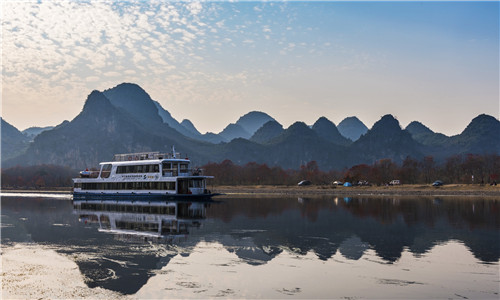
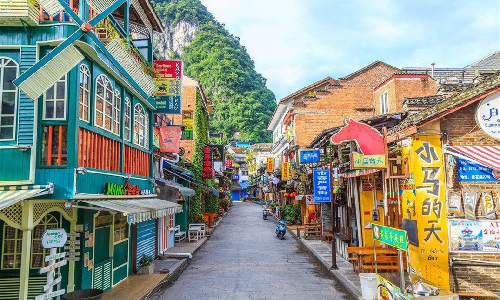
 Lijiang
Lijiang Today, we will take the estimated flight MF8635 10:40/12:35 to Lijiang. Lijiang, situated on the northwest border of Yunnan city, is not only a world-famous tourist city, but also a significant key position in the Southern Silk Road. It covers an area of over 20,600 square kilometers and has a permanent population of more than 1.25 million. There is not much difference of the four seasons here but only the rainy seasons and the dry seasons. It is about 2,000 meters above sea level and the ultraviolet ray is a bit strong. Don’t forget to pay attention to the temperature difference between day and night and pack enough clothes.
In the morning, we will drive to the north for about 44 minutes with a distance of 29 kilometers to the Jade Dragon Snow Mountain. The top of the mountain is blanketed by white snow all year long, which makes it look as if there is a white giant dragon lying on the mountain top. Therefore, this mountain is named as the “Jade Dragon Snow Mountain”. It is famous for its steepness and elegant beauty. You will visit the Blue Moon Valley here. The Blue Moon Valley area was once called the White Water River. White Water River is a river formed by the melted glacier water of Jade Dragon Snow Mountain. It got the name White Water River because the river bed is composed of sedimentary limestone debris, and when it rains, the sendiment will float up and make the water white. And the reason why it is later called "Blue Moon Valley" is because on a sunny day, the color of the water is blue, and the valley where it locates is crescent-shaped. When looking from a distance, it seems like a blue moon inlaid at the foot of the Jade Dragon Snow Mountain, so the scenic area is then named Blue Moon Valley.
In the afternoon, we will visit the Baisha Village, a quiet Naxi ancient village. Different from the bustling streets in the city, Baisha Village is the place where you can jump out of all your worries or worldly matters, and just enjoy the slow-speed leisure life. You can casually walk into a tea house or exotic bars, drink some beverage, and listen to the music played by local instruments of Naxi nationality. Inside the village, there are some traditional Baisha Murals with a history of about 500 years. It is a demonstration of the culture and art of the Naxi nationality. Although some murals are starting to get mottled, we can still have a glimpse of the open and inclusive Naxi culture. The content of the murals presents an all-embracing feeling towards different religions, such as Buddhism, Taoism, and Lamaism.
In the afternoon, we will visit the Shuhe Old Town. It is one of the earliest settlements of the Naxi ancestors in Lijiang, and is a well-preserved important market town on the ancient Tea Horse Road (a network of caravan paths in ancient times for trade). There are many exquisite stores and handicrafts for you to explore.
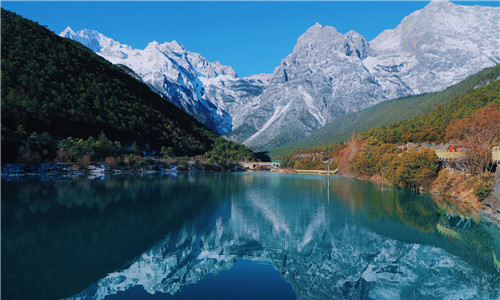
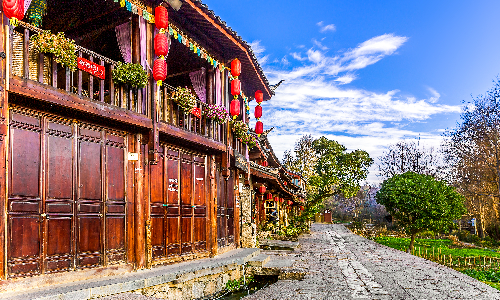
 Dali
Dali After breakfast this morning, we will first take you to the Tiger Leaping Gorge in the northwest of Lijiang City. It will take about 1.5 hours (80 kilometers) to drive there. The Tiger Leaping Gorge is the steepest, the most spectacular, and also the deepest gorge in the world. The views here are really splendid and breathtaking. It is said that a long time ago, a fierce tiger crossed the gorge with just one leap, and the gorge is then named Tiger Leaping Gorge.
Then, your guide will take you to the First Bend of Yangtze River. The Yangtze River runs down from the roof of the world, Qinghai-Tibetan Plateau, and passes by Yunnan. When it comes to Shigu County in Lijiang City, it suddenly takes a sharp turn with an angle of over 100 degrees. It has formed a very unusual V-shape area, called the First Bend of Yangtze River. Every year, many tourists are attracted to visit this splendid view.
Then, we will drive south for about 2 hours and 15 minutes to get to Dali. The travel distance is about 176 kilometers. Our next destination, Dali, is situated at the northwest corner of Yunnan province. It covers an area of 29, 459 square kilometers and has a permanent population of over 3.64 million people. There are many villages and small towns with minorities’ unique styles. You will be able to visit the famous freshwater lake-Erhai Lake, the famous Dali Old Town, and taste all sorts of delicacies of the local Bai minority. It is the dream place of lots of people, and a land where time seems to flow slower. Your guide will help you with checking in at the hotel in Dali. Have a nice rest!

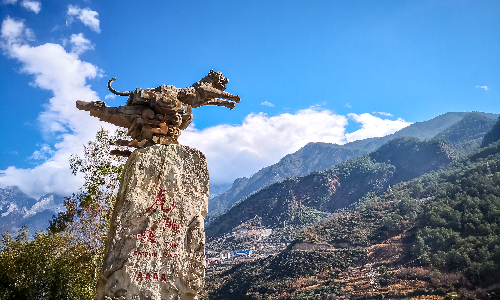
After your breakfast, we will take you to a place where you can fully appreciate the Chong Sheng Temple and Three Pagodas. There is one big pagoda in the middle and two small pagodas standing at both sides of it. Instead of going inside the tourist attraction, we plan to appreciate the three pagodas from the outside, which can help you save the ticket fees. Most importantly, standing a bit further is the best way to have a panoramic view of the pagodas and to get a group photo with all the three pagodas in the background.
Next, we will take you to Erhai Lake. The Erhai Lake covers a total area of 246 square kilometers. The shape of it is long and narrow. Walking around the attraction, you might find that Erhai Lake stretches as far as the eyes could see with nothing to block your sights. One of the most popular ways of sightseeing around the Erhai Lake is to rent a bicycle and ride around the lake (The bike ride is not included in our itinerary, and will be at your own expense if you would like to experience it). If you are not interested in riding a bike, just go to the nearby small shops to have a cup of tea or have a little chit-chat with people around if you can speak some Chinese.
In the afternoon, we will visit the Dali Old Town, the core area of tourism in Dali. It was built in 1382. The old town covers a total area of 3 square kilometers. All the major functional areas are divided in good order. Just follow your guide, or the direction signs, you can have a good visit inside. There are many things to do here, such as admiring the special handicrafts of local people, visiting some distinctive shops, and buying some hand-made local accessories. After some time here, our guide will take you back to your hotel.
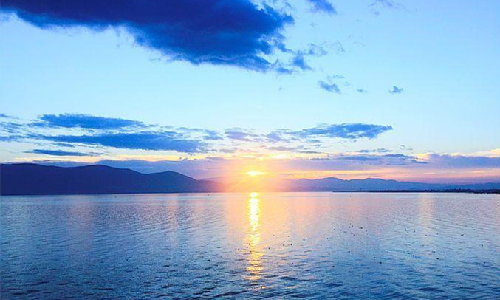
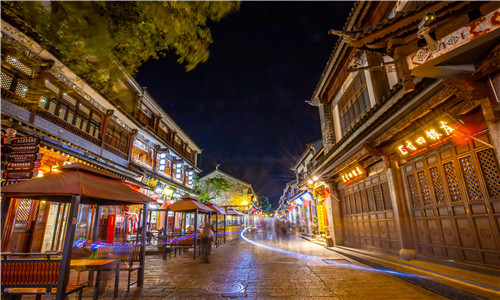
 Kunming
Kunming In the morning, you will take the estimated train D8662 08:22/10:43 to Kunming. Our local tour guide in Kunming will wait for you upon your arrival. Kunming is the provincial capital of Yunnan province, with a permanent population of over 6.85 million. It is also known as Spring City because of its pleasing climate all year round. The weather here in Kunming is really comfortable. The temperature remains at an average level throughout the year. And Kunming has the minimum annual temperature difference in China. Some say that Kunming only has one season all year round, that is spring. It is really a good place for people to live. Also, it is abundant in natural resources and cultural relics.
Upon arrival, we will take you directly to the famous attraction, Stone Forest. We will drive southeast for about 1 hour and 10 minutes (about 82 kilometers away from the train station). If you come to Kunming, you must visit the Stone Forest. Its reputation in Kunming is like the Forbidden City in Beijing. It is situated in the Yi Nationality Autonomous County of Kunming. It covers an area of 1,100 square kilometers, famous for its natural Karst landform. As the only xiphoid Karst geologic wonder situated in the subtropical plateau region in the world, it is called one of the eight best natural landscapes on earth. Inside the Stone Forest scenic area, there are several sub-attractions like the big stone forest, the small stone forest, the Naigu stone forest, and the long lake. The small stone forest attraction is also called Ashima attraction. The famous Ashima stone stands inside the attraction. In the minds of the people in Yi nationality, Ashima is the representative of beauty, kindness, and inner power. The legend of Ashima goes like this. Once upon a time, in Yunnan, a poor family gave birth to a beautiful girl, and named her “Ashima”. Ashima was not only beautiful, but also good at singing and dancing, many men in their village liked her. She fell in love with her childhood friend, the orphan Ahei, and vowed not to marry anyone but him. One year during the local torch festival, she and the brave Ahei betrothed. But another man, a rich man, named Azhi also fell in love with beautiful Ashima, and asked a matchmaker to persuade Ashima into marrying him instead of Ahei. No matter how hard the matchmaker persuaded, threatened, or enticed Ashima, she didn’t give in. Running out of ways, he took advantage of a time that Ahei went to a faraway place to herd sheep and kidnapped Ashima. When Ahei heard the news, he came back as fast as he could to save Ashima. According to the local custom, he and Azhi competed in singing, cutting down trees, sowing seeds and many other things, all of which Ahei won. Azhi was enraged and released three tigers to kill Ahei, who shot the tigers to death with three arrows and rescued Ashima. But vicious Azhi still didn’t give up, and colluded with the water demon to kill Azhi when he and Ashima was crossing a river. Yet accidentally, the water swept Ashima away instead of Azhi. A fairy saw this and helped with searching for Ashima. When they found her, she was no longer breathing. So the fariy turned her into a stone statue. And this is the stone statue of Ashima you see in the Stone Forest today. After the visit, you will be sent to the hotel to have a good rest.
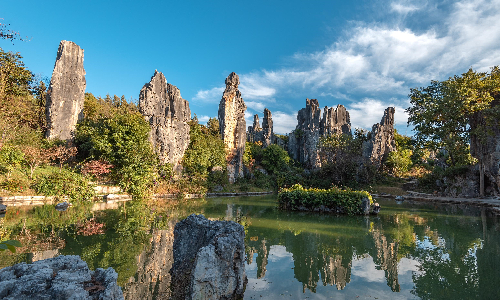
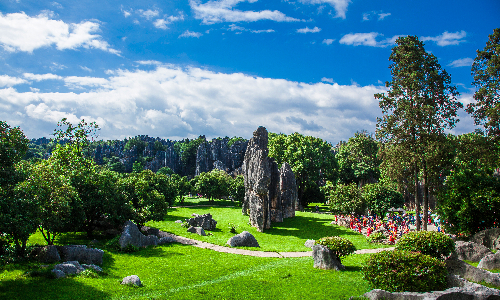
 Shanghai
Shanghai You will be transferred to the airport and take the estimated flight MU5803 9:00/11:55 from Kunming to Shanghai. Then let’s go on with our tour in a new city, Shanghai, well-known as the magic city of China. The population here is about 24 million. The economic aggregate and the average income per head in Shanghai both rank the first among all the cities in China. As one of the best-developed cities in China, Shanghai has been attracting the younger generation and people with talents to make a living here. Here in Shanghai, skyscrapers rise one after another. The modernization of Shanghai is really astounding. But among these high buildings, you can still discover that the traditional Shanghai-style has been well preserved. Here is Shanghai, a perfect combo of the modern and the traditional.
In the morning, we will first go to the Jade Buddha Temple, one of the ten famous attractions in Shanghai. It is well known for the jade Buddhas inside the temple, and the jade Buddhas are the reason why the temple got its name. History relates that monk Huigen (an eminent monk in the Qing Dynasty) is the founder and the first abbot of this temple. After going through many hardships, Huigen brought two jade Buddha statues, a reclined one and a sitting one, back from Burma. Then Huigen advocated building a temple to worship these two precious Buddha statues. This is how the Jade Buddha Temple was built. If you go there, you will be surprised to find out that: Although situated in the bustling streets, it is really a peaceful land that is completely isolated from the noise. Once you are there, you might be able to get away from the stress and obtain a peaceful mind.
Then, our next stop is the Yu Garden (closed each Monday), one of the representative masterpieces of Chinese classical gardens. It was originally built as a private garden in the Ming Dynasty. Then, in the year of 1961, it was officially opened to the public, so that the public can have a look at this ancient garden. The feature of this garden is: small but exquisite. Although it is small, it contains numerous delicate and elegant buildings. Once you are there, you might be amazed that basically every corner of the garden is just so fine and ingenious. And you can sit beside the pond in the Yu Garden, watch the goldfishes chasing around each other and some white ducks slowly moving around, patting the water. It will be really relaxing.
Afterward, your guide will take you to the Shanghai Old Street to get some snacks. Just as its name, the buildings there have a long history. But they are well-preserved and maintained, so you will have a chance to have a glimpse of the traditional architecture and local customs. Also, as a popular street that even local people will go to, the snacks won’t let you down. Let me name a few famous snacks here, such as soup dumplings, Qingtuan (a sweet green sticky rice ball), and Xiaolongbao (small steamed buns). The process of eating soup dumplings is a lot of fun. You might want to start with the broth spilling from the soup dumpling and then come to the stuffing. The stuffing is really abundant. Usually, it is made with all kinds of meat, such as crab, shrimp, and pork. Qing Tuan is a traditional delicacy for people in the south of China. Local people usually make Qingtuan around the period of spring. The most typical Qingtuan is made of sticky rice and red bean filling, which tastes soft and sweet. As for Xiaolongbao, it is pretty small, and you might be able to finish it within two bites. The locals usually dip it into a mixture of spicy paste and vinegar.
In the afternoon, we will go up to the Oriental Pearl TV Tower, one of the famous symbolic architecture in Shanghai. The tower is 468 meters high. It was built in 1991 and put into operation in 1995. During first the ten years after its founding, it has received about 295 foreign leaders and has held more than 100 world-class important conferences as well as about 300 big events. And you can imagine how popular it is nowadays. Though many tourist groups choose to visit the Shanghai Tower, we can promise that right in the Oriental Pearl TV Tower, you can enjoy the same panoramic view of Shanghai at a cheaper price.
The next stop is the Bund, another famous attraction in Shanghai. The Bund is 1.5 meters long, along the Huangpu River. Once you are on the Bund, the first thing that attracts your sight might be the group of approximately 30 elegant exotic buildings there, which is called the “the Exotic Building Clusters”. The splendid scenery on the Bund has attracted enormous tourists from home and abroad.
Next, you will be taken to the Nanjing Road. The Nanjing Road is a popular commercial street among tourists and the local people. The street is bustling all year round and all day long with people. Let me introduce a few famous shops to you. If you don’t know where to go, just come to these famous ones. “Shen Dacheng”, a really popular shop even among the younger generations, is a century-old brand in making traditional Chinese dim-sum and cakes. The most famous one should be the Qingtuan. Here in the shop, the Qingtuan is bigger than the normal ones but relatively cheaper. The techniques of making Qingtuan have been passed on by generations in this shop. The flavor has been verified by time and every generation. “Shao Wansheng”, a very popular shop among local people, mainly sells all kinds of marinated meat. Every year, when the weather gets hotter, Shanghai people would like to come here to get some meat. Nowadays, it also sells some moon-cakes stuffed with their special meat. The next famous shop we will introduce to you, “Zhang Xiaoquan”, is a century-old brand, and mainly sells utilities used in the kitchen, such as chopsticks, scissors, and knives. You can get a good souvenir of traditional Chinese cooking utensils.
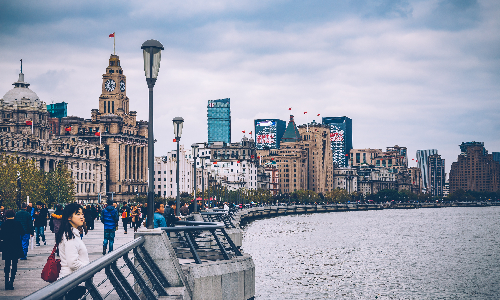
Our journey will come to an end. Our local tour guide will send you to the airport according to your boarding time.
Author: Yang Yawen
Proofreader: Li Yiwen
| City | Five Star hotel list | Four Star hotel list |
|---|---|---|
| Beijing | Sunworld Dynasty Hotel Beijing Wangfujing | Sunworld Hotel Wangfujing |
| Xi'an | Tianyu Gloria Grand Hotel Xi'an | Sunworld Dynasty Hotel |
| Chengdu | Sofitel Chengdu Taihe | Holiday Inn Express Chengdu Jinniu |
| Guilin | Lijiang Waterfall Hotel | Guilin Bravo Hotel |
| Lijiang | Wonderport International Hotel | Lijiang Wangfu Hotel |
| Dali | The One Hotels & Resorts | Landscape Hotel |
| Kunming | Grand Park Kunming | UChoice Hotel |
| Shanghai | Ocean Hotel Shanghai | Ambassador Hotel |
 |
![]() About your child or infant, please contact us for a discounted price.
About your child or infant, please contact us for a discounted price.



We started with a few days in Beijing & ended in Shanghai, from where we visited the Forbidden City and Great Wall. In between we visited Terra Cotta Warriors Museum, Panda Base, Shanghai Disneyland.

We had a wonderful holiday in China which will remain long in the memory. China is a breathtakingly beautiful country full of splendid temples and palaces, mountains and rivers, peaceful rural scenes and bustling shopping streets.
 QUICK ENQUIRY
QUICK ENQUIRY